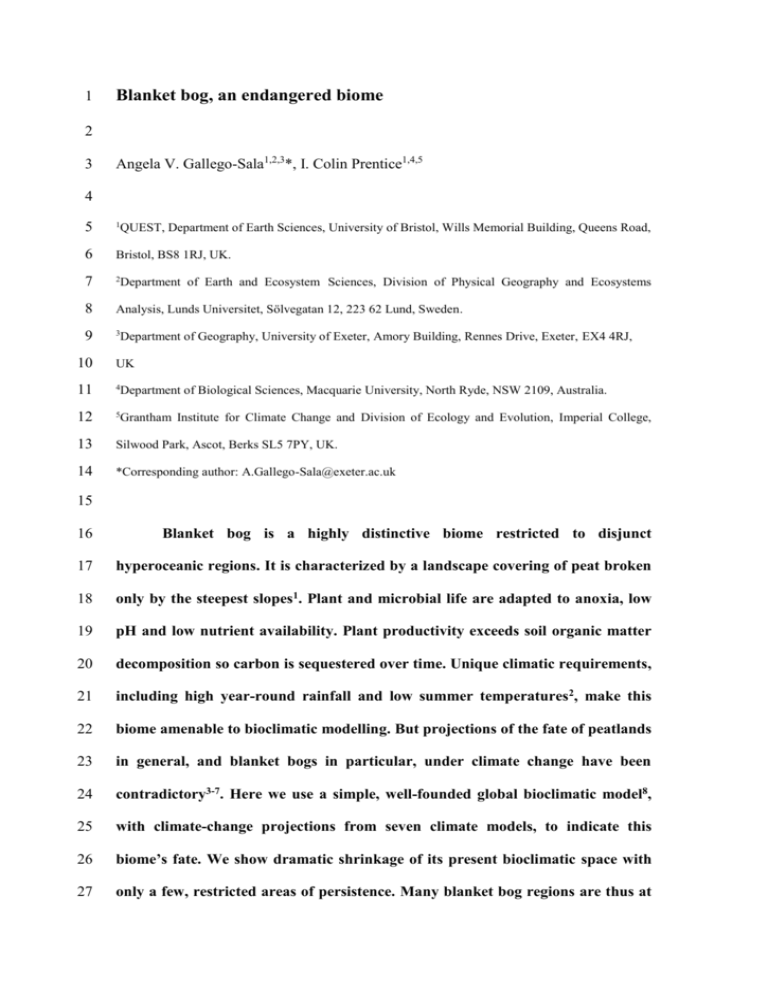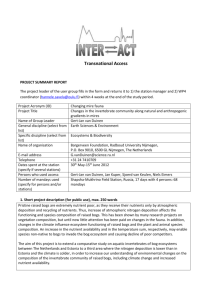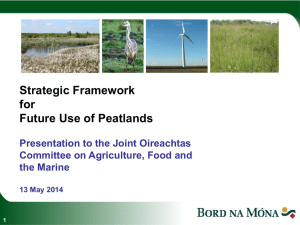Gallego-Sala and Prentice final submission
advertisement

1 Blanket bog, an endangered biome 2 3 Angela V. Gallego-Sala1,2,3*, I. Colin Prentice1,4,5 4 5 1 6 Bristol, BS8 1RJ, UK. 7 2 8 Analysis, Lunds Universitet, Sölvegatan 12, 223 62 Lund, Sweden. 9 3 QUEST, Department of Earth Sciences, University of Bristol, Wills Memorial Building, Queens Road, Department of Earth and Ecosystem Sciences, Division of Physical Geography and Ecosystems Department of Geography, University of Exeter, Amory Building, Rennes Drive, Exeter, EX4 4RJ, 10 UK 11 4 12 5 13 Silwood Park, Ascot, Berks SL5 7PY, UK. 14 *Corresponding author: A.Gallego-Sala@exeter.ac.uk Department of Biological Sciences, Macquarie University, North Ryde, NSW 2109, Australia. Grantham Institute for Climate Change and Division of Ecology and Evolution, Imperial College, 15 16 Blanket bog is a highly distinctive biome restricted to disjunct 17 hyperoceanic regions. It is characterized by a landscape covering of peat broken 18 only by the steepest slopes1. Plant and microbial life are adapted to anoxia, low 19 pH and low nutrient availability. Plant productivity exceeds soil organic matter 20 decomposition so carbon is sequestered over time. Unique climatic requirements, 21 including high year-round rainfall and low summer temperatures2, make this 22 biome amenable to bioclimatic modelling. But projections of the fate of peatlands 23 in general, and blanket bogs in particular, under climate change have been 24 contradictory3-7. Here we use a simple, well-founded global bioclimatic model8, 25 with climate-change projections from seven climate models, to indicate this 26 biome’s fate. We show dramatic shrinkage of its present bioclimatic space with 27 only a few, restricted areas of persistence. Many blanket bog regions are thus at 28 risk of progressive peat erosion and vegetation changes as a direct consequence 29 of climate change. New areas suitable for blanket bog are also projected, but are 30 often disjunct from present areas and their location inconsistently predicted by 31 different climate models. 32 Blanket bogs (Supplementary Figure 1) are found almost exclusively in the 33 high-latitude, oceanic fringes of the continents and on subpolar islands1. In Europe 34 they occur in Iceland, Ireland, Great Britain, coastal Norway (terrengdekkende myr) 35 and Faroe Islands. In North America they occur in parts of Nova Scotia, Quebec, 36 southern Labrador and Newfoundland and near the Pacific coast of Alaska. In South 37 America they are widespread on the Falkland Islands and in Patagonia (turberas 38 magallanicas or turberas de cobertura) and in the Paramos of Ecuador and Colombia. 39 They are found in Asia on Kamchatka and Hokkaido and in Australasia at high 40 elevations in New Guinea (hard-cushion bogs), western Tasmania (button-grass 41 moorlands) and New Zealand (pakihi or cushion bogs), although these have been 42 described as “incipient” blanket bogs. Another type of blanket bog, also called 43 orogenic blanket bog or condensation mire, occurs in certain high elevation wet areas 44 of the Alps in Central Europe, the Ruwenzori Mountains in Uganda. Wherever they 45 occur, blanket bogs are treeless peatlands dominated by hummock- or cushion- 46 forming vascular plants, typically with an understorey of Sphagnum and other 47 bryophytes9. They present a distinctive surface pattern that can vary from slight 48 cushioning to a full microtope zonation consisting of wet pools or hollows, lawns, and 49 drier hummocks. Deer grass (Trichophorum cespitosum), and cotton grass 50 (Eriophorum spp.) impart to the blanket bogs of Britain their typical hummocky 51 appearance, while purple moor grass (Molinia caerulea) and black bog rush 52 (Schoenus nigricans) are common in Ireland10. These species are also found in 53 blanket bogs in Norway and along the eastern Canadian coast, Newfoundland and 54 coastal Alaska, together with labrador tea (Ledum groenlandicum), bog laurel (Kalmia 55 spp.) and crowberry (Empetrum nigrum)11. Other cushion-forming species, such as 56 asterid (Donatia fascicularis), oreob (Oreobolus obtusangulus) and astelia (Astelia 57 pumila) dominate blanket bog in Patagonia12. A different asterid (Donatia novae- 58 zelandiae) and a restionaceous sedge (Calorophus minor) are typical of blanket bog in 59 New Zealand while buttongrass (Gymnoschoenus sphaerocephalus) is representative 60 for blanket bog in Tasmania13. 61 Blanket bog is a waterlogged and unproductive environment, but a haven for 62 wildlife nonetheless, providing shelter to birds, small mammals, amphibians and 63 reptiles. Within this ecosystem, there is also a great diversity of microbial metabolic 64 processes adapted to anoxia and low nutrients, including syntropic or homoacetogenic 65 bacteria, and hydrogenotrophic methanogenic archaea18. 66 Blanket bogs are sensitive to climate because their existence depends on a 67 permanently high water table7 and because the characteristic Sphagnum spp. rapidly 68 suffer damage at temperatures > 15˚C3. Bioclimatic models have been used to model 69 the regional extent of different peatland types14-16, but to our knowledge no global 70 model for blanket bog distribution was published before Gallego-Sala et al. (2010)8. 71 Other models of wetland distribution based on the topographic index have been used 72 recently to predict the global distribution of peatlands in general17,18 but do not 73 distinguish blanket bog. 74 PeatStash8 is an extremely simple, yet process-oriented, model. It is not a 75 statistical “niche model”. Instead it defines independent limit values for three 76 bioclimatic variables, each representing a different controlling process. The blanket 77 bog distribution map compiled in ref. 1 was used to calibrate the limit values for the 78 climatic moisture index (see Methods) (MI > 2.1), mean annual temperature (MAT > 79 1˚C) and mean temperature of the warmest month (MTWA < 14.5 ˚C), resulting in 80 the global distribution shown in Figure 1. These variables stand for year-round 81 moisture (required to maintain the water table), absence of permafrost (avoiding 82 cryoturbation and ice-wedge formation, which are responsible for quite different 83 peatland morphologies in very cold climates), and avoidance of high temperatures 84 (damaging to Sphagnum). When forced by a high-resolution climate data set, the 85 model closely reproduces the distribution of blanket bog in Great Britain 8, which is 86 much more accurately known than the global distribution. Sensitivity analysis 87 underlines the vulnerability of the blanket bog climate space to increases in 88 temperature above all (Figure 2), but also to reductions in precipitation - in agreement 89 with independent statistical modelling16,19 - and to a lesser extent to reductions in 90 cloudiness. Note that the model describes controls on the occurrence of blanket bog; 91 it does not make predictions about peat accumulation rates. These behave in a 92 substantially different way, responding positively to warming and negatively to 93 cloudiness20. 94 The model predicts the known occurrence areas of blanket bog. It also suggests 95 that climatically, blanket bogs could exist near the Northwestern Black Sea coast of 96 Georgia and in the border region of Georgia/Azerbaijan, in the Himachal Pradesh, 97 Uttarakhand and Arunachal Pradesh regions of the Himalayan foothills and high 98 elevation areas in Taiwan. We have not been able to confirm or reject the occurrence 99 of blanket bogs in these regions as there is very little published information on 100 wetlands or peatlands of any sort. 101 To analyse potential climate change impacts we used climate change scenarios for 102 the last three decades of the 21st century derived from seven general circulation 103 models, normalized so that all scenarios produced a warming of 2 K by mid-century21 104 (see Methods). A consistent pattern across models involves shrinkage of the climate 105 space for blanket bog (Figures 3 and 4a) with only small core areas persisting within 106 each region. Some new areas potentially suitable for blanket bog appear, for example, 107 at higher elevations in Norway, northern Labrador, higher elevations in Kamchatka, 108 and the Chukotka peninsula and St Lawrence Island on the Bering Strait (Figure 3). 109 Across all regions, however, there is better agreement among models on the 110 prediction of shrinkage (a 50 to 59% decrease within the existing area) than expansion 111 (9 to 39% additional area). The driver of this shrinkage is increasing temperature 112 (Figure 4b), which acts both directly through warming summers and indirectly by 113 lowering MI. Precipitation increases are the main driver of the modelled expansion to 114 new areas, and climate model projections of precipitation are less consistent than 115 temperature. These findings are in line with analyses suggesting an expansion of bogs 116 and retreat of the tree-line in some northern oceanic regions4 even as the suitability of 117 the present distribution area for blanket bog is reduced. 118 Shrinkage of the bioclimatic space for blanket bog in many areas does not 119 necessarily entail rapid disappearance of the biome with consequent oxidation of the 120 accumulated peat to atmospheric CO2. This kind of prediction is outside the capability 121 of our model. Nevertheless, regions falling outside the envelope will be under stress 122 from climate change and unlikely to continue growing and acting as carbon sinks6. 123 The resilience of peat to environmental changes has been highlighted previously and 124 rapid carbon losses may be avoidable especially if Sphagnum moss cover can be 125 maintained22. Blanket bogs have survived climatic changes in the past through 126 internal changes in microtope patterns and changes in vegetation assemblages. 127 However the biome cannot remain indefinitely in a relict state and it is likely that the 128 cover of Sphagnum and other bryophytes will decline, leaving the affected regions 129 vulnerable to peat erosion. This decline may be counterbalanced to an unknown 130 extent by development of blanket bog in the limited areas at higher latitudes and/or 131 elevations that become newly suitable for blanket bog to develop, a process requiring 132 the replacement of existing vegetation and the initiation of peat growth in a new 133 location. 134 135 Methods 136 The PeatStash model. The program STASH, originally used to estimate the present 137 distribution of European trees23, was adapted to delimit the potential distribution of 138 blanket bog8. STASH calculates several bioclimatic variables from long-term monthly 139 means of temperature, precipitation, and the fraction of possible sunshine hours (a 140 measure inversely related to cloud cover). PeatStash calculates mean temperature of 141 the warmest month, mean annual temperature, and a moisture index (MI) following 142 the definition given by the United Nations Environment Programme (1992)24: 143 144 MI = P /PET [1] 145 146 where P is the mean annual precipitation (mm) and PET is the mean annual potential 147 evapotranspiration (mm). We substitute equilibrium evapotranspiration, calculated 148 from monthly net radiation and temperature as in Prentice et al. (1991)25 for PET. 149 This substitution is neutral from the modelling point of view because PET according 150 to the Priestley-Taylor equation is proportional to the equilibrium evapotranspiration. 151 Climate data. We used a gridded long-term mean climatology (temperature, 152 precipitation, fractional sunshine hours) for the period 1931-1960 (CLIMATE 2.2) as 153 the baseline for our modelling experiments. Version 2.2 of CLIMATE includes more 154 high-latitude station data and an improved estimation of the elevational gradients of 155 climate variables26 relative to the original version by Leemans and Cramer27. 156 Future climate projections. Future climate projections for the period 2070-2099 were 157 based on seven climate models’ A1B scenario runs carried out for the IPCC Fourth 158 Assessment Report28. The runs were processed by the QUEST GSI project 159 (http://www.cru.uea.ac.uk/~timo/climgen/data/questgsi/) using ClimGen, a tool 160 developed by Mitchell and Osborn (2005)29 to generate normalized climate change 161 fields using pattern scaling30. The fields were normalized to yield a 2 K global mean 162 temperature increase at 2050. The global average increase of land temperature for 163 2070-2099 relative to the baseline period (1931-1960) was between 3.9 and 4.3 K 164 (Table 1), a much smaller range than the “native” predictions of the models because 165 of their differing climate sensitivities to radiative forcing. The normalization 166 effectively removes the effect of climate sensitivity so that the remaining differences 167 between the models are in the simulated seasonal and spatial patterns of temperature 168 and precipitation changes. The models used were CGCM3, the third-generation 169 coupled global climate model from the Canadian Centre for Climate Modelling and 170 Analysis (CCCma); the Commonwealth Scientific and Industrial Research 171 Organisation (CSIRO) Mark III model (Australia); the IPSL (version IPSLCM4) 172 model from the Institute Pierre Simon Laplace (France); the ECHAM5 model from 173 the Max Plank Institute for Meteorology (Germany); CCSM (Community Climate 174 System Model) version 3.0, from the US National Center for Atmospheric Research 175 (NCAR); HadCM3 from the Met Office Hadley Centre (UK); and HadGEM1 from 176 the Met Office Hadley Centre (UK). 177 Scenario-independent sensitivity analysis. Temperature, precipitation and fractional 178 sunshine hours were varied, one at a time, by adding or subtracting a given amount or 179 percentage to/from all monthly values. 180 Scenario-dependent sensitivity analysis. To assess the drivers of modelled changes, 181 we applied projected climate values for each variable (temperature, precipitation and 182 sunshine fraction) one at a time while keeping the other variables constant at their 183 baseline values. 184 185 Acknowledgements 186 We are grateful to the Environment Agency (Science project sc070036) and the 187 Natural Environment Research Council (NERC), through the Quantifying and 188 Understanding the Earth System (QUEST) programme, for funding the development 189 of PeatStash. Martin Sykes at Lund University provided the STASH code, and Fran 190 Bragg at Bristol helped with the climate change scenarios. Climate change scenarios 191 were provided by the QUEST GSI project, funded by NERC. We are indebted to Joy 192 Hecht, Ben Ridge, Susana Velásquez-Franco, Rene Limeres and Martin Rimmer for 193 providing pictures of blanket bogs. 194 195 Author Contributions 196 A.G.S. carried out model runs and analysis and wrote the first draft. I.C.P. supervised 197 the project and contributed to experimental design, interpretation of results, and the 198 final draft. 199 Additional Information 200 The authors declare no competing financial interest. 201 202 Figure captions 203 204 205 Figure 1. The global potential area of blanket bog, predicted from climate data using the PeatStash model. Ice caps and areas where no climate data are available (e.g. Antarctica) are shown in light grey. 206 207 208 209 210 211 212 213 214 215 216 217 218 219 220 221 222 223 Figure 2. Percentage change in blanket bog potential area for a constant change in (a) mean monthly temperature (°C), (b) mean monthly precipitation, or (c) mean monthly sunshine fraction. 224 Tables: 225 226 227 228 229 Table 1: Predicted increase of terrestrial mean annual temperature for the period 2070-2099, according to pattern-scaled scenarios based on seven climate models: all normalized to yield a global warming of 2 K at 2050. 230 231 232 233 234 235 236 237 238 239 240 241 242 243 244 245 246 247 248 249 250 Figure 3. Projected changes to blanket bog potential area for seven climate change scenarios compared to the standard period. The scenarios were derived by pattern scaling, assuming a 2 K warming by 2050, resulting in a warming of 3.9 to 4.5 K over land during 2070-2099. The colour scale represents number of climate models predicting new appearance (blue) or disappearance (red) of blanket bog potential area. Light grey shading as in Figure 1. Figure 4. a) Projected changes to blanket bog potential area for different regions: EUR = Europe, SA = South America, WNA = western coast of North America, ENA= eastern coast of North America, KAM = Kamchatka, Hokkaido and the Bering Strait, NZ = New Zealand (South Island) and Tasmania. These regions have different surface areas; the changes shown are percentages of present area. b) Percentage decrease or increase of blanket bog potential area due to the projected changes of climatic variables taken one at a time: T = temperature, P = precipitation, S = sunshine fraction. GCM CCCMA CSIRO HadCM3 HadGEM IPSL ECHAM NCAR ∆Tmean 4.5 4.4 4.4 3.9 4.3 3.9 1 2 3 4 5 6 4.5 Charman, D. J. in Peatlands and Environmental Change Ch. 1, 3-23 (John Wiley & Sons Ltd, 2002). Wieder, R. K. & Vitt, D. H. Boreal Peatland Ecosystems. 435 (2006). Bragazza, L. A climatic threshold triggers the die-off of peat mosses during an extreme heat wave. Global Change Biology 14, 2688-2695 (2008). Crawford, R. M. M., Jeffree, C. E. & Rees, W. G. Paludification and Forest Retreat in Northern Oceanic Environments. Ann Bot 91, 213-226, doi:10.1093/aob/mcf185 (2003). Gignac, L. D., Nicholson, B. J. & Bayley, S. E. The Utilization of Bryophytes in Bioclimatic Modeling: Predicted Northward Migration of Peatlands in the Mackenzie River Basin, Canada, as a Result of Global Warming. The Bryologist 101, 572-587 (1998). Ise, T., Dunn, A. L., Wofsy, S. C. & Moorcroft, P. R. High sensitivity of peat decomposition to climate change through water-table feedback. Nature Geoscience 1, 763-766, doi:10.1038/ngeo331 (2008). 251 252 253 254 255 256 257 258 259 260 261 262 263 264 265 266 267 268 269 270 271 272 273 274 275 276 277 278 279 280 281 282 283 284 285 286 287 288 289 290 291 292 293 294 295 296 297 298 7 8 9 10 11 12 13 14 15 16 17 18 19 20 21 22 Ellis, C. J. & Tallis, J. H. Climatic control of blanket mire development at Kentra Moss, north-west Scotland. Journal of Ecology 88, 869-889 (2000). Gallego-Sala, A. V. et al. Bioclimatic envelope model of climate change impacts on blanket peatland distribution in Great Britain. Climate Research Uplands Special Issue, 151-162 (2010). Moore, P. D. The future of cool temperate bogs. Environmental Conservation 29, 3-20, doi:10.1017/s0376892902000024 (2002). Laine, A., Byrne, K., Kiely, G. & Tuittila, E.-S. Patterns in vegetation and CO2 dynamics along a water level gradient in a lowland blanket bog. Ecosystems 10, 890-905, doi:citeulike-article-id:7853064 (2007). Davis, A. M. Ombrotrophic peatlands in Newfoundland, Canada: Their origins, development and trans-Atlantic affinities. Chemical Geology 44, 287309 (1984). Kleinebecker, T., HÖLzel, N. & Vogel, A. Patterns and gradients of diversity in South Patagonian ombrotrophic peat bogs. Austral Ecology 35, 1-12, doi:10.1111/j.1442-9993.2009.02003.x (2010). Whinam, J. & Hope, G. S. The peatlands of the Australasian region. Moore von Sibirien bis Feuerland - Mires - from Siberia to Tierra del Fuego. Biologiezentrum der Oberoesterreichischen Landesmuseen Neue Serie 35 (2005). Gignac, L. D., Nicholson, B. J. & Bayley, S. E. The utilization of bryophytes in bioclimatic modeling: Present distribution of peatlands in the Mackenzie River Basin, Canada. Bryologist 101, 560-571 (1998). Gignac, L. D., Halsey, L. A. & Vitt, D. H. A bioclimatic model for the distribution of Sphagnum-dominated peatlands in North America under present climatic conditions. Journal of Biogeography 27, 1139-1151 (2000). Parviainen, M. & Luoto, M. Climate envelopes of mire complex types in Fennoscandia. Geografiska Annaler Series a-Physical Geography 89A, 137151 (2007). Kleinen, T., Brovkin, V. & Schuldt, R. J. A dynamic model of wetland extent and peat accumulation: results for the Holocene. Biogeosciences 9, 235-248, doi:10.5194/bg-9-235-2012 (2012). Ringeval, B. et al. An attempt to quantify the impact of changes in wetland extent on methane emissions on the seasonal and interannual time scales, under review. Global Biogeochemical Cycles (2010). Clark, J. et al. Assessing the vulnerability of blanket peat to climate change using an ensemble of statistical bioclimatic envelope models Climate Research Uplands Special Issue (2010). Charman, D. J. et al. Climate-driven changes in peatland carbon accumulation during the last millennium. PNAS (in revision). Natural Environment Research Council. QUEST Global-Scale Impacts (GSI) of climate change: an integrated multi-sectoral assessment, [Internet]. Accessed 2009. http://badc.nerc.ac.uk/view/badc.nerc.ac.uk__ATOM__dataent_12233055204 826764. NCAS British Atmospheric Data Centre (2008). Woike, M. & Schmatzler, E. Moore. Bedeutung - Schutz - Regeneration. In Lindsay (2009) Peatlands and carbon - a critical synthesis to inform policy development. A Report for Discussion., (Deutscher Naturschutzring, 1980). 299 300 301 302 303 304 305 306 307 308 309 310 311 312 313 314 315 316 317 318 319 320 321 322 323 324 23 24 25 26 27 28 29 30 Sykes, M. T., Prentice, I. C. & Cramer, W. A Bioclimatic Model for the Potential Distributions of North European Tree Species Under Present and Future Climates. Journal of Biogeography 23, 203-233 (1996). United Nations Environment Programme. World Atlas of Desertification. (1992). Prentice, I. C., Sykes, M. T. & Cramer, W. The Possible Dynamic Response of Northern Forests to Global Warming. Global Ecology and Biogeography Letters 1, 129-135 (1991). Kaplan, J. O. et al. Climate change and Arctic ecosystems: 2. Modeling, paleodata-model comparisons, and future projections. Journal of Geophysical Research-Atmospheres 108, doi:10.1029/2002jd002559 (2003). Leemans, R. & Cramer, W. The IIASA database for mean monthly values of temperature, precipitation and cloudiness of a global terrestrial grid. Report RR-91-18. (1991). IPCC. Climate Change 2007: The Physical Science Basis. Contribution of Working Group I to the Fourth Assessment Report of the Intergovernmental Panel on Climate Change. (2007). Mitchell, T. D. & Osborn, T. J. ClimGen: a flexible tool for generating monthly climate data sets and scenarios. Tyndall Centre for Climate Change Research Working Paper (in preparation). (2005). Mitchell, T. D., Carter, T. R., Jones, P. D., Hulme, M. & M.G., N. A comprehensive set of high-resolution grids of monthly climate for Europe and the globe: the observed record (1901–2000) and 16 scenarios (2001–2100). Tyndall Centre Working Paper No.55, Tyndall Centre. (2004).








